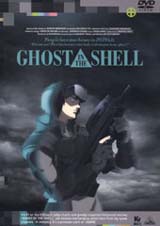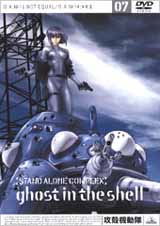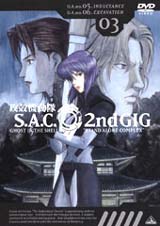Into the Network: The Ghost in the Shell Universe
1995: Ghost in the Shell
Mamoru Oshii's feature anime Ghost in the Shell, released in 1995 and based on Shirow Masamune's original comic book, significantly influenced the subculture scene around the globe, and overwhelmed the audiences at the time with cutting edge digital visual effects as well as with detailed drawings, visual arts and a unique philosophical approach. Later in May 1996, when the movie video was released in the USA, it soared to the top of the Billboard Sell Video Charts and sold more than one million copies, which made it one of the biggest Japanese animation works ever sold there.
2002: Stand Alone Complex
In October 2002, pay-per-view distribution of a TV series based on the same characters, Ghost in the Shell: Stand Alone Complex, started in Japan on SkyPerfecTV!'s Animax Channel. A record breaking 800 million yen was invested for the production of this single TV series.
The director for the series was Kenji Kamiyama. Already sequence director in Jin-Roh and scriptwriter in Blood: The Last Vampire, Kamiyama has a unique background: he joined the anime industry as an art specialist and later took up directing. When he was working on Jin-Roh, he joined Oshii's workshop, "Oshii Team," at Production I.G. His debut as a director was in 2002 with MiniPato, a self-parody of the popular series Mobile Police Patlabor, based on an original script by Mamoru Oshii.
When he started Stand Alone Complex, Kamiyama decided to roughly position it as "a relative" of the original comic and the feature anime. He then shifted the overall atmosphere to a police action drama, in which the so-called "Laughing Man Incident" is used as an original underlying story throughout the entire series.
Stand Alone Complex takes place in the year 2030, and it is based on the assumption that Major Motoko Kusanagi did not meet the Puppet Master in 2029. In other words, it stands as a separate parallel world to both Shirow Masamune's original comic and Director Oshii's movie. Motoko in this TV series uncompromisingly handles cases as the leader of Section 9, unlike her film version counterpart, who is portrayed as being insecure about herself.
2004: S.A.C. 2nd Gig
Stand Alone Complex was originally planned as a 26-episode series, but the production of a second season of additional 26 episodes was quickly decided immediately after TV airing started. Then. in January 2004, pay-per-view distribution of S.A.C. 2nd Gig started on SkyPerfecTV!'s Animax Channel. This time Mamoru Oshii participated in the project by contributing the story concept at the initial stage. His ideas were: "the story should involve war" and "create a strong adversary to the Section 9". He virtually traced a road map for the project. Thus the new series has become an all the more intense drama surrounding the Information Bureau of the Prime Minister's Office and the Section 9 going head-to-head against each other.
And then...
2005: Stand Alone Complex is Back!
In Japan, the two seasons sold a total of over 1.3 million DVDs. In North America, every DVD volume is selling over 100,000 copies, making the Stand Alone Complex series a worldwide mega hit.
And now, SAC and 2nd Gig have been both re-edited as two full-length features: Stand Alone Complex: The Laughing Man (released on September 23, 2005) and Stand Alone Complex 2nd Gig: Individual Eleven (released on January 27, 2006).
Though using the original TV footage, in order to make the drawings consistent and to make the story flow smoothly, new cuts were added and additional post-recordings and re-dubbing sessions were carried out. Also, they were produced in a state of the art environment - high-definition picture with 5.1 surround sound - as was the TV series. This marks the birth of an all-new Stand Alone Complex.




![WORK LIST[DETAILS]](/contents/works/design/images/left_title.gif)



 terms of use
terms of use